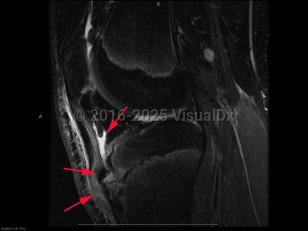Osgood-Schlatter disease in Adult
Alerts and Notices
Important News & Links
Synopsis
Causes / typical injury mechanism: Osgood-Schlatter disease (OS), also known as juvenile osteochondrosis of the tibial tubercle, is a disorder involving inflammation, pain, and swelling of the tibial tuberosity. It is most common in young adolescents, particularly those regularly involved in athletics. OS typically occurs soon after a growth spurt. Symptoms last for 12-18 months, often resolving spontaneously with the closure of the physeal plate of the tibia, although there is a small subset of patients who experience pain after skeletal maturation.
Classic history and presentation: Affected patients often present with an acutely tender and swollen bump over the tibial tubercle. It may present bilaterally or unilaterally. Some patients may have a limp. OS is usually exacerbated by exercise and improves with rest.
Prevalence: OS was historically shown to affect predominantly boys, but more recent investigations have shown similar rates in girls, likely due to the rise in female athletic participation over the last several decades. It is estimated to affect between 10%-20% of adolescent athletes. Girls typically experience symptoms at an earlier age than boys (10-13 years versus 11-14 years, respectively), corresponding with the earlier onset of pubertal growth in girls.
Risk factors: Risk factors include participation in sports that involve jumping and pivoting, including soccer, basketball, gymnastics, and volleyball. Additionally, there may be limited evidence to show associations with increased body weight and tightness / flexibility of the quadriceps and hamstring muscles.
Pathophysiology: The underlying pathophysiology of OS is poorly understood. Its association with sports participation has led to the hypothesis that it is related to repeated small injuries to the developing knee associated with traction from the patellar tendon.
Classic history and presentation: Affected patients often present with an acutely tender and swollen bump over the tibial tubercle. It may present bilaterally or unilaterally. Some patients may have a limp. OS is usually exacerbated by exercise and improves with rest.
Prevalence: OS was historically shown to affect predominantly boys, but more recent investigations have shown similar rates in girls, likely due to the rise in female athletic participation over the last several decades. It is estimated to affect between 10%-20% of adolescent athletes. Girls typically experience symptoms at an earlier age than boys (10-13 years versus 11-14 years, respectively), corresponding with the earlier onset of pubertal growth in girls.
Risk factors: Risk factors include participation in sports that involve jumping and pivoting, including soccer, basketball, gymnastics, and volleyball. Additionally, there may be limited evidence to show associations with increased body weight and tightness / flexibility of the quadriceps and hamstring muscles.
Pathophysiology: The underlying pathophysiology of OS is poorly understood. Its association with sports participation has led to the hypothesis that it is related to repeated small injuries to the developing knee associated with traction from the patellar tendon.
Codes
ICD10CM:
M92.40 – Juvenile osteochondrosis of patella, unspecified knee
SNOMEDCT:
72047008 – Juvenile osteochondrosis of tibial tubercle
M92.40 – Juvenile osteochondrosis of patella, unspecified knee
SNOMEDCT:
72047008 – Juvenile osteochondrosis of tibial tubercle
Look For
Subscription Required
Diagnostic Pearls
Subscription Required
Differential Diagnosis & Pitfalls

To perform a comparison, select diagnoses from the classic differential
Subscription Required
Best Tests
Subscription Required
Management Pearls
Subscription Required
Therapy
Subscription Required
References
Subscription Required
Last Reviewed:08/13/2020
Last Updated:10/12/2020
Last Updated:10/12/2020
Osgood-Schlatter disease in Adult

